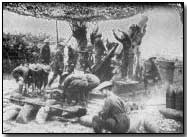Battles - The Battle of Pozieres Ridge, 1916
 A subsidiary attack of the Somme Offensive, and
launched on 23 July 1916, the Battle of Pozieres Ridge on the Albert-Bapaume
road saw the Australians and British fight hard for an area that comprised a
first rate observation post over the surrounding countryside, as well as the
additional benefit of offering an alternative approach to the rear of the
Thiepval defences.
A subsidiary attack of the Somme Offensive, and
launched on 23 July 1916, the Battle of Pozieres Ridge on the Albert-Bapaume
road saw the Australians and British fight hard for an area that comprised a
first rate observation post over the surrounding countryside, as well as the
additional benefit of offering an alternative approach to the rear of the
Thiepval defences.
The Australian divisions of the I Anzac Corps, having served in Gallipoli, were primarily given the task of capturing the Pozieres Ridge, which had in fact been intended for capture on the first day of the Somme Offensive. This the Australians succeeded in doing by 4 August, having launched their offensive almost two weeks earlier at 1.30 am on 23 July, a mere two days following their arrival on the Somme. They were assisted in the attack by the British 48th Division to the Australians' west, attacking from Ovillers towards the German left flank.
The Australians succeeded in capturing Pozieres village itself within an hour; after which they rushed across the main road onwards towards Gibraltar, a German strongpoint. A mere 200 yards separated the Australians from Pozieres Ridge, the attack's main objective, heavily defended by the securely entrenched German troops. Two lines of trenches needed to be overcome before the ridge could be claimed.
Later on that first day, 23 July, the Australians were joined to the north-west of Pozieres village by the British 17th Warwickshire Regiment. Still the ridge remained firmly in German hands. The 2nd Australian Division subsequently relieved their comrades and continued the attack on the ridge for a further four days before they too were relieved. Allied casualties at this stage were running at a costly 3,500.
The ridge finally fell, after almost two weeks of bitter fighting, on 4 August, although both Mouquet Farm and Thiepval remained under German control. Failed attempts directed by Hubert Gough to push further north-west from the height of the hard-won narrow salient towards Mouquet Farm and Thiepval were heavily repulsed by German artillery fire, with the loss of some 23,000 Australian troops.
Gough came under Australian criticism for his persistence in pushing the advance for five weeks; their growing scepticism of the quality of British leadership had already taken a blow following the notable failure of an earlier subsidiary attack at Fromelles, west of Lille, a veritable mud bath, on 19-20 July by the Australian 5th Division, intended to divert German attention away from the Somme.
During this minor action the Australians nevertheless suffered 5,708 casualties, of which total 4,000 were fatalities; a further 400 were captured and marched by the Germans through Lille as prisoners of war.
Photograph courtesy of Photos of the Great War website
The Western Front Today: Gibraltar
The Western Front Today: Pozieres British Cemetery
The Western Front Today: Australian Memorial, Pozieres Mill
Bulgaria mobilised a quarter of its male population during WW1, 650,000 troops in total.
- Did you know?
